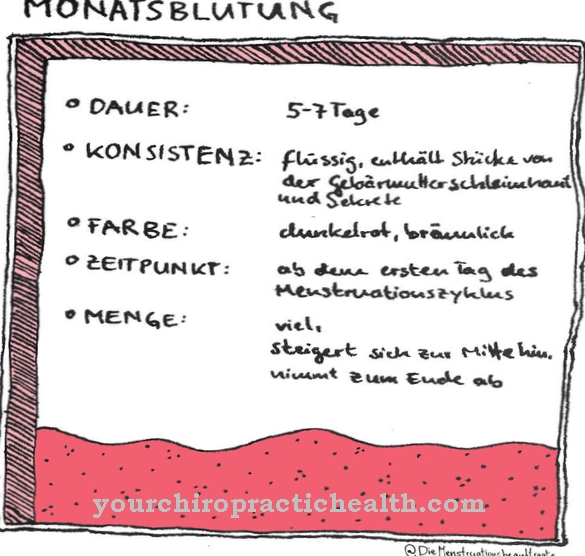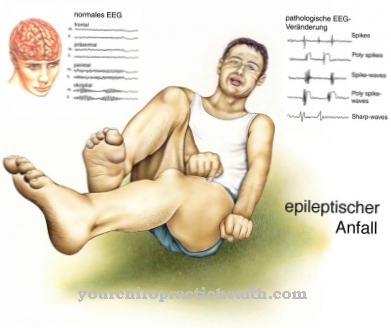In the Chagas disease, Chagas disease or South American thrypanosomiasis it is an infectious disease that is not triggered by bacteria, viruses or fungi, but by a parasite. Chagas disease was first described by Carlos Chagas in 1909.
What is Chagas Disease?

© underdogstudios - stock.adobe.com
Chagas disease is also known as Chagas disease or South American thrypanosomiasis. It got this name because the disease is mainly common in South and Central America.
The World Health Organization (WHO) estimates that around ten million people in Latin America have Chagas disease. The Brazilian infectiologist Carlos Chagas first came across the strange tropical disease in 1909. He discovered that predatory bugs were responsible for transmitting the infectious disease and gave the parasite the name Trypanosoma cruzi - based on a well-known doctor from Brazil who gave the institute its name at which Chagas worked at the time.
The insidious Chagas disease occurs predominantly in rural areas and is no longer limited to South America. With the increasing mobility of the population, Chagas disease has also been diagnosed in countries like Canada, the United States, and some European and West Pacific countries.
causes
Chagas disease is a parasitic infectious disease. The unicellular parasite Trypanosoma cruzi is the cause of the disease. Predatory bugs act as intermediate hosts (vectors), ingesting the pathogen through blood meals and excreting it through their feces.
The pathogens of Chagas disease can get into their hosts via the smallest skin injuries or mucous membrane contacts. In the case of mammals, dogs, cats, isolated rodents, armadillos and possums in particular are affected as hosts. The infection is passed on to humans through the animals.
Here it is again possible that an infection can also take place from person to person (for example via an organ transplant, a blood transfusion or in the womb to the unborn child). In Chagas disease, the pathogens enter the bloodstream and attack the cells of the muscles and the heart.
Symptoms, ailments & signs
Chagas disease is accompanied by various general symptoms of infection, although there are also some characteristic symptoms that can directly indicate the disease. First and foremost, Chagas disease leads to a very high fever and thus to tiredness and fatigue in the person concerned. Most patients continue to suffer from shortness of breath and are therefore severely restricted in their everyday life.
It also leads to diarrhea and severe abdominal pain.The lymph nodes can also be swollen from Chagas disease, which is often noticeable on the neck. If the disease is not treated, it usually leads to retention of water. These occur mainly on the face or on the feet and can also have a negative effect on the aesthetics of the person affected.
Heart problems also occur, with most patients suffering from palpitations or heart pain. As the disease progresses, cardiac death occurs, reducing the life expectancy of the person affected if Chagas disease is not treated. The disease can also cause the intestinal organs to break through and, in the worst case, lead to the death of the person affected.
Diagnosis & course
Chagas disease can be diagnosed particularly well in the first few weeks after infection. The parasite can be detected in a blood smear under the microscope. Chronic Chagas disease can be characterized by the significant enlargement of the affected parts of the organs (for example, the enlargement of the heart, the enlargement of the esophagus and the colon).
In addition to the microscopic detection of Chagas disease, xenodiagnosis can also be carried out. This means that the blood-sucking predatory bugs are grown in the laboratory and then placed on the patient's skin. After a few weeks, the Trypanosoma cruzi pathogen can be detected in the faeces of the predatory bugs.
The incubation period for Chagas disease is around three weeks. After this time, skin irritation occurs at the infection site, the so-called chagom. Other symptoms of Chagas disease are edema, fever, difficulty breathing, diarrhea, cramps, abdominal pain, and swelling of the lymph nodes.
Complications
Chagas disease can cause changes in the heart if left untreated. This can result in life-threatening complications. This increases the risk of cardiac arrhythmias such as atrial or ventricular fibrillation developing. With atrial fibrillation, the blood can no longer be pumped properly, it remains in the atrium (stasis of the blood).
As a result, the blood can clot on the wall of the atrium, forming a thrombus that can loosen and is carried on with the bloodstream. This can lead to further consequences such as a pulmonary embolism, which causes chest pain and shortness of breath in the affected person, or a stroke, which, depending on the situation, is characterized by a wide variety of paralysis and deficiency symptoms.
In addition, pulmonary edema can develop in Chagas disease. This can lead to inflammation in the lung tissue (pneumonia), which in the worst case can develop into sepsis. In the acute phase of Chagas disease, inflammation of the brain (encephalitis) or heart muscle inflammation (myocarditis) are also possible.
This may result in paralysis or heart failure (heart failure). Some nerve cells, which are required for the muscles and thus the movement of the gastrointestinal organs, are also damaged. This can cause the food to build up, which can cause an ileus or enlarge the organs. This can lead to a breakthrough of the intestinal organs, which can also lead to death.
When should you go to the doctor?
If typical symptoms such as fever and shortness of breath occur, medical advice is required. The doctor can diagnose Chagas disease with the help of a blood smear and, if necessary, initiate treatment directly. A doctor's visit is necessary at the latest if further complications arise. An emergency doctor should be called immediately in the event of chest pain and shortness of breath. If pulmonary edema or a stroke occurs, first aid should be given immediately.
The sick person then has to spend some time in the hospital and also needs comprehensive medical and therapeutic care afterwards. Psychological help is also recommended to relatives if the disease is severe. After contact with dogs, cats, and rodents, the risk of contracting Chagas disease is particularly high. Likewise after an organ transplant or a blood transfusion. If these factors apply to you, you should consult a doctor quickly. In addition to the general practitioner, a specialist in infectious diseases can also help. In case of doubt, the medical emergency service or the ambulance service should be contacted.
Doctors & therapists in your area
Treatment & Therapy
Untreated Chagas disease results in death in approximately ten percent of affected patients. Infants, toddlers, the elderly and people with weak immune systems are most at risk. Chagas disease can only be treated with drugs. However, this treatment is difficult.
Therapy is carried out with the drugs nifortimox or benznidazole. However, these have serious side effects and can even change the patient's genetic makeup (so-called mutagens). In addition, there are even pathogens that are resistant to the drugs. In the acute phase, i.e. the initial phase of Chagas disease, attempts are made to combat Trypanosoma cruzi directly.
The antibiotic agents nifortimox and benznidazole can in most cases destroy the parasite at the onset of Chagas disease. The duration of treatment is between seven weeks and three months. However, the longer Chagas disease lasts, the more difficult it becomes to find an effective remedy for the infection. In the chronic phase of Chagas disease, it is no longer enough to just want to fight the pathogen.
Only a targeted therapy of the individual symptoms can lead to success in the fight against Chagas disease. The later the treatment is carried out, the more likely it is to cause cardiac arrhythmias, arterial embolisms or pulmonary edema.
Outlook & forecast
In the worst case, Chagas disease can lead to death of the patient and must therefore be treated in any case. However, death usually only occurs if the disease is left completely untreated. People with a weakened immune system or old age patients are particularly at risk.
The disease itself is treated with the help of medication, whereby the symptoms can be completely limited. In some cases, different drugs need to be tested for effectiveness before the right drug is found.
Chagas disease can also become chronic and cause permanent discomfort. Here, those affected are then dependent on treatment of the heart and lungs, as these organs are affected by the disease.
An early diagnosis and treatment of Chagas disease always has a positive effect on its course and can avoid further complications or, in the worst case, death of the person concerned. Some home remedies can help relieve symptoms of the disease. The further course of the disease continues to depend on the extent of the organ damage.
prevention
For the prophylaxis of Chagas disease, the fight against predatory bugs is mainly used. For example, insecticidal wall paints are used. You can also protect yourself against bedbug bites with suitable clothing and mosquito nets. The predatory bugs like to live in the sleeping areas of pets. These places should be segregated. A vaccination against Chagas disease does not yet exist.
Aftercare
In most cases of Chagas disease, there are very few direct follow-up measures available to those affected. With this disease, a quick and, above all, an early diagnosis is very important so that there are no further complications or complaints. In the worst case, Chagas disease can lead to death.
The patient should not be in the affected areas and should protect himself as well as possible from mosquitoes. Various sprays can be used, although long clothing should be worn that properly covers all parts of the body. Self-healing cannot occur with this disease.
Most of the time, Chagas disease is treated with medication. The person concerned should pay attention to the correct dosage and regular intake of the medication. Since antibiotics are administered in most cases, they must not be taken with alcohol.
Absolute bed rest must also be observed with this disease. The patient should not engage in strenuous or physical activity. The disease itself is not contagious and can only be transmitted through the mosquito bite, so that the support of other people is allowed.
You can do that yourself
A doctor should be consulted immediately if Chagas disease is suspected. Medical treatment is always required due to the severity of the infection. Nevertheless, there are some home remedies and measures that you can use to relieve symptoms on your own.
In mild cases of the disease, treatment with homeopathic preparations makes sense. The use of globules and Co. should always be done in consultation with a doctor and cannot completely replace antibiotic treatment. Any medicinal plants should also be used purely symptomatically. Thyme, elderberry or speedwell help against fever, while diarrhea can be treated with bloodroot, oak and blueberry. Diet or purification can help if there are symptoms of the lymphatic system.
However, if medical treatment is given too late, it can lead to cardiac arrhythmias, pulmonary edema and other complications. Depending on how severe these complications are, the doctor will then refer the patient to a therapist. This is especially necessary if Chagas disease has caused permanent damage to the internal organs. The loss of quality of life must be dealt with in any case and accepted in the long term.


.jpg)









.jpg)



.jpg)










.jpg)
